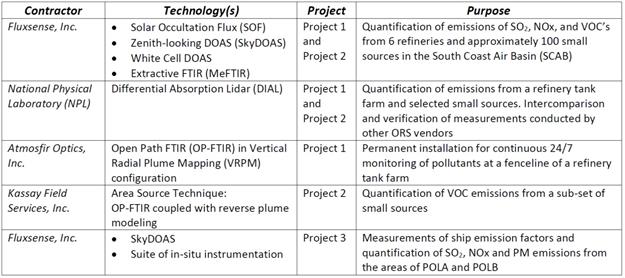Modern atmospheric optical remote sensing (ORS) techniques offer unique capabilities for monitoring trace gas emissions from point and area sources in near-real time. These spectroscopic methods allow for an absolute determination of the path averaged gas concentration and, for certain applications, a direct determination of emission fluxes. This capability can be especially valuable for identifying leaks from fugitive emission sources, which are often extremely challenging to identify and/or quantify. ORS methods do not require instrument calibration and can be used for continuous monitoring of gaseous pollutants from outside of the fenceline of a facility. Watch the short video below to learn the basic principles of atmospheric remote sensing.
2015 Optical Remote Sensing Study
In the fall of 2015 the South Coast AQMD conducted three ORS projects to characterize emissions from refineries, small stationary sources, marine vessels, and the ports.
The table below provides a list of the contractors that participated in this study and an overview of the technologies that were deployed during the three projects.

A presentation summarizing the main findings of the three 2015 ORS projects can be found here
For more information on each project, click on the links below:
Project 1: Quantification of Fugitive Emissions from Large Refineries
Project 2: Quantification of Gaseous Emissions from Gas Stations, Oil Wells, and Other Small Point Sources
Project 3: Quantification of Stack Emissions from Marine Vessels
Controlled Release Experiment
In 2012-2014 South Coast AQMD funded two ORS technology demonstration studies.
The fist was conducted by Dr. Jochen Sttuz research group at the University of California Los Angeles (UCLA) and focused on the deployment of a variety of different ORS instruments for refinery fenceline monitoring and community alert. These ORS technologies included:
-
Long Path Differential Optical Absorption Spectroscopy (LP-DOAS)
-
Multi-Axis DOAS (MAX-DOAS)
-
Imaging DOAS (I-DOAS)
-
Open Path Fourier Transform Spectroscopy (OP-FTIR))
The second study was conducted by Fluxsense Inc. and focused on demonstrating the capabilities of multiple ORS methods on a mobile platform to characterize and quantify refinery emissions. These ORS technologies included:
Click on the icons below to download the final reports from these studies.